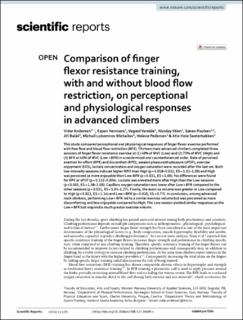| dc.contributor.author | Andersen, Vidar | |
| dc.contributor.author | Hermans, Espen | |
| dc.contributor.author | Vereide, Vegard Albert | |
| dc.contributor.author | Stien, Nicolay | |
| dc.contributor.author | Paulsen, Gøran | |
| dc.contributor.author | Baláš, Jiří | |
| dc.contributor.author | Michailov, Michail Lubomirov | |
| dc.contributor.author | Pedersen, Helene | |
| dc.contributor.author | Sæterbakken, Atle Hole | |
| dc.date.accessioned | 2023-10-12T13:01:26Z | |
| dc.date.available | 2023-10-12T13:01:26Z | |
| dc.date.created | 2023-03-10T12:44:00Z | |
| dc.date.issued | 2023 | |
| dc.identifier.citation | Scientific Reports. 2023, 13(2023), Artikkel 3287. | en_US |
| dc.identifier.issn | 2045-2322 | |
| dc.identifier.uri | https://hdl.handle.net/11250/3096162 | |
| dc.description | This article is licensed under a Creative Commons Attribution 4.0 International License, which permits use, sharing, adaptation, distribution and reproduction in any medium or format, as long as you give appropriate credit to the original author(s) and the source, provide a link to the Creative Commons licence, and indicate if changes were made. The images or other third party material in this article are included in the article's Creative Commons licence, unless indicated otherwise in a credit line to the material. If material is not included in the article's Creative Commons licence and your intended use is not permitted by statutory regulation or exceeds the permitted use, you will need to obtain permission directly from the copyright holder. | en_US |
| dc.description.abstract | This study compared perceptional and physiological responses of finger flexor exercise performed with free flow and blood flow restriction (BFR). Thirteen male advanced climbers completed three sessions of finger flexor resistance exercise at (1) 40% of MVC (Low) and (2) 75% of MVC (High) and (3) BFR at 40% of MVC (Low + BFR) in a randomized and counterbalanced order. Rate of perceived exertion for effort (RPE) and discomfort (RPD), session pleasure/displeasure (sPDF), exercise enjoyment (EES), lactate concentration and oxygen saturation were recorded after the last set. Both low-intensity sessions induced higher RPD than High (p = 0.018–0.022, ES = 1.01–1.09) and High was perceived as more enjoyable than Low-BFR (p = 0.031, ES = 1.08). No differences were found for RPE or sPDF (p = 0.132–0.804). Lactate was elevated more after High than the Low-sessions (p < 0.001, ES = 1.88–2.08). Capillary oxygen saturation was lower after Low + BFR compared to the other sessions (p = 0.031, ES = 1.04–1.27). Finally, the exercise volume was greater in Low compared to High (p = 0.022, ES = 1.14) and Low + BFR (p = 0.020, ES = 0.77). In conclusion, among advanced male climbers, performing Low + BFR led to a similar exercise volume but was perceived as more discomforting and less enjoyable compared to High. The Low session yielded similar responses as the Low + BFR but required a much greater exercise volume.
ERRATA: The original version of this Article contained an error in the order of the Figures. Figures 1 and 2 were published as Figures 2 and 1. As a result, the Figure legends were incorrect. | en_US |
| dc.language.iso | eng | en_US |
| dc.subject | muscle | en_US |
| dc.subject | psychology | en_US |
| dc.title | Comparison of finger flexor resistance training, with and without blood flow restriction, on perceptional and physiological responses in advanced climbers | en_US |
| dc.type | Peer reviewed | en_US |
| dc.type | Journal article | en_US |
| dc.description.version | publishedVersion | en_US |
| dc.rights.holder | © The Author(s) 2023 | en_US |
| dc.source.pagenumber | 8 | en_US |
| dc.source.volume | 13 | en_US |
| dc.source.journal | Scientific Reports | en_US |
| dc.identifier.doi | 10.1038/s41598-023-30499-x | |
| dc.identifier.cristin | 2133020 | |
| dc.description.localcode | Institutt for fysisk prestasjonsevne / Department of Physical Performance | en_US |
| dc.source.articlenumber | 3287 | en_US |
| cristin.ispublished | true | |
| cristin.fulltext | original | |
| cristin.qualitycode | 1 | |

